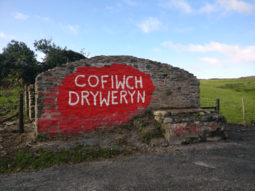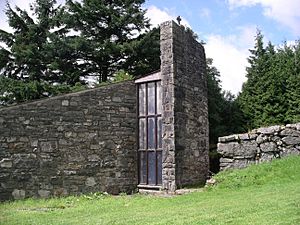Tryweryn flooding facts for kids

The Tryweryn flooding or Tryweryn drowning (Welsh: Boddi Tryweryn), refers to the flooding of the rural community of Capel Celyn to the north west of Bala in Gwynedd, Wales, in the Afon Tryweryn valley. The village and other parts of the valley were flooded in 1965 to create Llyn Celyn reservoir, in order to supply Liverpool and Wirral with water for industry.
The Tryweryn flooding was opposed by 125 local authorities and 27 of 36 Welsh MPs voted against the second reading of the bill with none voting for it. At the time, Wales had no Welsh office (introduced in 1964) or any devolution.
History
In 1957, a private bill sponsored by Liverpool City Council was brought before Parliament to develop a water reservoir in the Tryweryn Valley. The development would include the flooding of Capel Celyn. By obtaining authority via an Act of Parliament, Liverpool City Council would not require planning consent from the relevant Welsh local authorities and would also avoid a planning inquiry at Welsh level at which arguments against the proposal could be expressed. This, together with the fact that the village was one of the last Welsh-only speaking communities in the area, ensured that the proposals became deeply controversial; 35 out of 36 Welsh Members of Parliament (MPs) opposed the bill (the other did not vote), but in 1962 it was passed. The members of the community waged an eight-year effort, ultimately unsuccessful, to prevent the destruction of their homes.
The Tryweryn flooding was opposed locally by the Capel Celyn Defense Committee led by Dafydd Roberts and Elizabeth May Watkin Jones. by 125 local authorities and 27 of 36 Welsh MPs voted against the second reading of the bill with none voting for it. At the time, Wales had no Welsh office (introduced in 1964) or any devolution.
When the valley was flooded in 1965, the village and its buildings, including the post office, the school, and a chapel with cemetery, were all lost. Twelve houses and farms were submerged, and 48 people of the 67 who lived in the valley lost their homes. In all, some 800 acres (3.2 km2; 320 ha) of land were submerged. A new reservoir, Llyn Celyn, was formed.
The water in the reservoir is used to maintain the flow of the River Dee (Afon Dyfrdwy) so that water may be abstracted downstream, and additionally to improve the quality of white-water sports on Afon Tryweryn.
A full list of the submerged properties (broadly from west to east) is as follows:
|
|
Stones from the chapel (built in 1820 and rebuilt in 1892) and other buildings in the village were used in the construction of Capel Celyn Memorial Chapel, designed by the Welsh sculptor R. L. Gapper with the Liverpool City architect Ronald Bradbury, which was completed in 1967 and overlooks the reservoir at the north-west end. It is a Grade II* listed building.
Families who had relatives buried in the cemetery were given the option of moving them to another cemetery. Eight bodies were disinterred and the remainder left. All headstones were supposed to be removed, and the cemetery was to be covered in layers of gravel, then concrete, but this was not done.
When the reservoir dried due to a drought in the 1980s and early 1990s the village became visible. The whole of the walled cemetery next to where the chapel stood was completely covered in concrete. There were no gravestones left standing. The removed headstones are in a memorial garden at the memorial chapel.
Hafod Fadog
One of the farmsteads covered was Hafod Fadog, a Quaker meeting place. It is recorded on a bronze plaque in a lay-by near to the dam:Under these waters and near this stone stood Hafod Fadog, a farmstead where in the seventeenth and eighteenth centuries Quakers met for worship. On the hillside above the house was a space encircled by a low stone wall where larger meetings were held, and beyond the house was a small burial ground. From this valley came many of the early Quakers who emigrated to Pennsylvania, driven from their homes by persecution to seek freedom of worship in the New World.
Political effects
Almost unanimous Welsh political opposition had failed to stop approval of the scheme, a fact that seemed to underline Plaid Cymru's argument that the Welsh national community was powerless. At the subsequent general election, the party's support increased from 3.1% to 5.2%.
Of perhaps greater significance, however, was the impetus the episode gave to Welsh devolution. The Council for Wales recommended the creation of a Welsh Office and Secretary of State for Wales early in 1957, a time when the governance of Wales on a national level was so demonstrably lacking in many people's eyes. By 1964 the Wilson government gave effect to these proposals.
The flooding of Capel Celyn also sharpened debate within Plaid Cymru about the use of direct action. While the party emphasised its constitutional approach to stopping the development, it also sympathised with the actions of two party members who (of their own accord) attempted to sabotage the power supply at the site of the Tryweryn dam in 1962.
A more militant response was the formation of Mudiad Amddiffyn Cymru ("Wales Defence Movement") or MAC, which blew up a transformer on the dam construction site in February 1963. MAC went on to carry out a number of other bombings in the next six years.
In October 1965, the Llyn Celyn reservoir opened, and there was a sizeable Plaid Cymru-organised demonstration. A year later, Gwynfor Evans won Plaid Cymru's first parliamentary seat in Carmarthen. But according to some commentators, Capel Celyn did not play a major part in Gwynfor Evans's victory: in addition to Carmarthen's long distance from Tryweryn, they claim that Plaid Cymru's victory owed as much to an anti-Labour backlash in the constituency's mining communities as it did to Plaid's successful depiction of Labour's policies as a threat to the viability of small Welsh communities.
On 19 October 2005, Liverpool City Council issued a formal apology for the flooding. Some in the town of Bala welcomed the move, though others said the apology was a "useless political gesture" and came far too late.
Impact on Welsh law
The flooding is often cited in discussions around devolving powers to the Welsh Government, such as those following the Government of Wales Act 2006 and the Wales Act 2014. The 2015 United Kingdom election took place during the flooding's 50 year anniversary, and saw the UK Conservative Party campaign on the St David's Day Agreement which would give further powers to the Welsh government.
The agreement's proposals effectively meant that any Welsh laws on water could be overruled by UK ministers if they judged it would have a serious adverse effect on the water supply in England. As such, the proposals were heavily criticised in Wales; both the Welsh Government and Plaid Cymru stated that a new agreement was needed to address the issues around devolved, reserved and excepted matters, especially on the emotive subject of water.
In backing the UK government's proposals, Secretary of State for Wales Alun Cairns directly referenced the Tryweryn flooding, stating that the UK proposals were "about righting a wrong from 50 years ago", adding that UK Government proposed settlement "sends a strong message" on how the UK and Welsh governments relate to each other.
The discussions would eventually lead the UK government losing the power to intervene in any laws relating to water (and many other areas) enacted by the Welsh Government, with supporters of the new Wales Act 2017 describing it as "preventing another Tryweryn". Alun Cairns again backed the amended act, stating that the new arrangement showed "how far we have come from the events of 52 years ago, which resulted in the flooding of the Tryweryn Valley".
Cofiwch Dryweryn
Cofiwch Dryweryn ("Remember Tryweryn") is a motto referring to the drowning of Capel Celyn in 1965. It urges Welsh speakers to remember the destruction of a Welsh-speaking community and to safeguard the language. One instance of this motto is a graffito on the wall of a ruined stone cottage by the A487 at Llanrhystud, outside Aberystwyth which has come to be regarded as a "national landmark". Meic Stephens claimed to have been the first to paint the wall in the 1960s, with the slogan Cofiwch Tryweryn (sic, without the initial soft mutation and therefore grammatically incorrect). Since then, a number of people have repainted the wall, and the word Tryweryn has been corrected to Dryweryn.
In 2010, a fundraising campaign was launched to preserve the wall by Llanrhystud Community Council. £80,000 was needed, with Cadw declaring that it would contribute £30,000 to the fund.
The wall has been vandalised over on a number of occasions. In May 2008, the words were altered to "Angofiwch Dryweryn" ('forget Tryweryn'). The monument was defaced in April 2010, and a spokesperson for the Welsh Government said they were "disappointed" by the incident. Incidents of vandalism also occurred throughout the years, e.g. in 2013 and 2014. In 2017, the words Cofiwch Aberfan 1966 ("Remember Aberfan") were added underneath the original message. This message was referring to the Aberfan disaster of 1966, when the collapse of a colliery spoil tip above the village of Aberfan led to the deaths of 144 people, 116 of them children. The original message was repainted in August 2018 but was again defaced in February 2019, when it was painted over with the name Elvis, a reference to the American rock-and-roll singer Elvis Presley. After the memorial was repainted, vandals knocked over parts of the wall. In response to the vandalism a wave of Cofiwch Dryweryn memorials were painted throughout Wales and further afield also.
The monument is featured in the music video for the Manic Street Preachers' single "Distant Colours".
See also
- Epynt clearance
- Mynydd Epynt
- Derwent, Derbyshire (similar village 'drowned' to create a reservoir)
- Ashopton
- Mardale
- History of Liverpool




